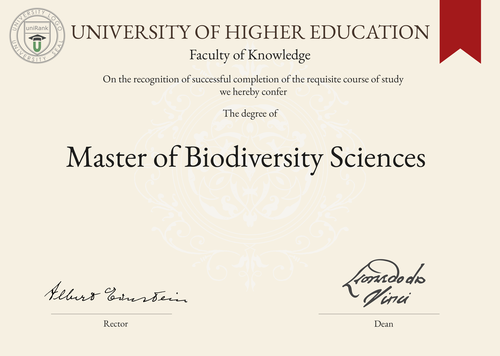
Master of Biodiversity Sciences (MBS)
Guide to Master of Biodiversity Sciences Program/Course/Degree
Master of Biodiversity Sciences (MBS)

Program Name
Master of Biodiversity SciencesProgram or Degree abbreviation
MBSDuration range
The duration of the Master of Biodiversity Sciences program typically ranges from 1 to 2 years.Tuition range
The tuition fees for the Master of Biodiversity Sciences program can vary depending on the chosen country or university. It is recommended to check with specific institutions for accurate information.Overview
The Master of Biodiversity Sciences program is designed to provide students with a comprehensive understanding of biodiversity and its conservation. It focuses on the study of various ecosystems, species and their interactions, as well as the impact of human activities on biodiversity.Curriculum Overview by year
The curriculum of the Master of Biodiversity Sciences program is structured to cover a wide range of topics related to biodiversity. The following is a general overview of the curriculum by year: Year 1: - Introduction to Biodiversity - Conservation Biology - Ecology and Ecosystems - Evolutionary Biology - Research Methods in Biodiversity Sciences Year 2: - Biodiversity Assessment and Monitoring - Conservation Genetics - Environmental Policy and Management - Elective Courses - Research Project or ThesisKey Components
The key components of the Master of Biodiversity Sciences program include: - In-depth knowledge of biodiversity and its conservation - Practical skills in biodiversity assessment and monitoring - Understanding of ecological and evolutionary processes - Proficiency in research methods and data analysis - Awareness of environmental policy and management strategiesCareer Prospects
Graduates of the Master of Biodiversity Sciences program can pursue various career paths in both public and private sectors. Potential career prospects include: - Conservation Scientist - Environmental Consultant - Wildlife Biologist - Ecologist - Researcher - Environmental Policy AnalystSalary Expectations
The salary expectations for individuals with a Master of Biodiversity Sciences degree can vary depending on factors such as job position, location and level of experience. Salaries in this field can range from moderate to high, with opportunities for growth and advancement. For a more accurate understanding of salary expectations, you can utilize the Job Sites Search Engine, from our sister site jobRank, which searches over 4,600 job sites worldwide. Make sure to specify not only the job title but also the country you are interested in.Conclusions:
It is important to note that the duration, tuition fees, curriculum, key components, career prospects and salary expectations of the Master of Biodiversity Sciences program can vary depending on the chosen country or location of study, as well as the specific university. Prospective students are advised to research and compare different institutions to find the best fit for their academic and career goals. Visitors interested in pursuing a Master of Biodiversity Sciences degree can use the uniRank World Universities Search Engine to search for universities offering this program anywhere in the world. This tool provides a comprehensive database of universities and their respective programs, allowing individuals to find the most suitable options for their educational journey.World Universities Search Engine
search for Master of Biodiversity Sciences (MBS) and add the Location (country, state etc.) or specific University you are interested in studying at.
Query examples:
- Master of Biodiversity Sciences (MBS) United States
- Master of Biodiversity Sciences (MBS) United Kingdom online
- Master of Biodiversity Sciences (MBS) Australia international students
- Master of Biodiversity Sciences (MBS) University of California
- Master of Biodiversity Sciences (MBS) University of London tuition fees
- Master of Biodiversity Sciences (MBS) University of Sydney scholarships
Share Program/Course
Interesting? Share this program/course/degree info with your friends now.